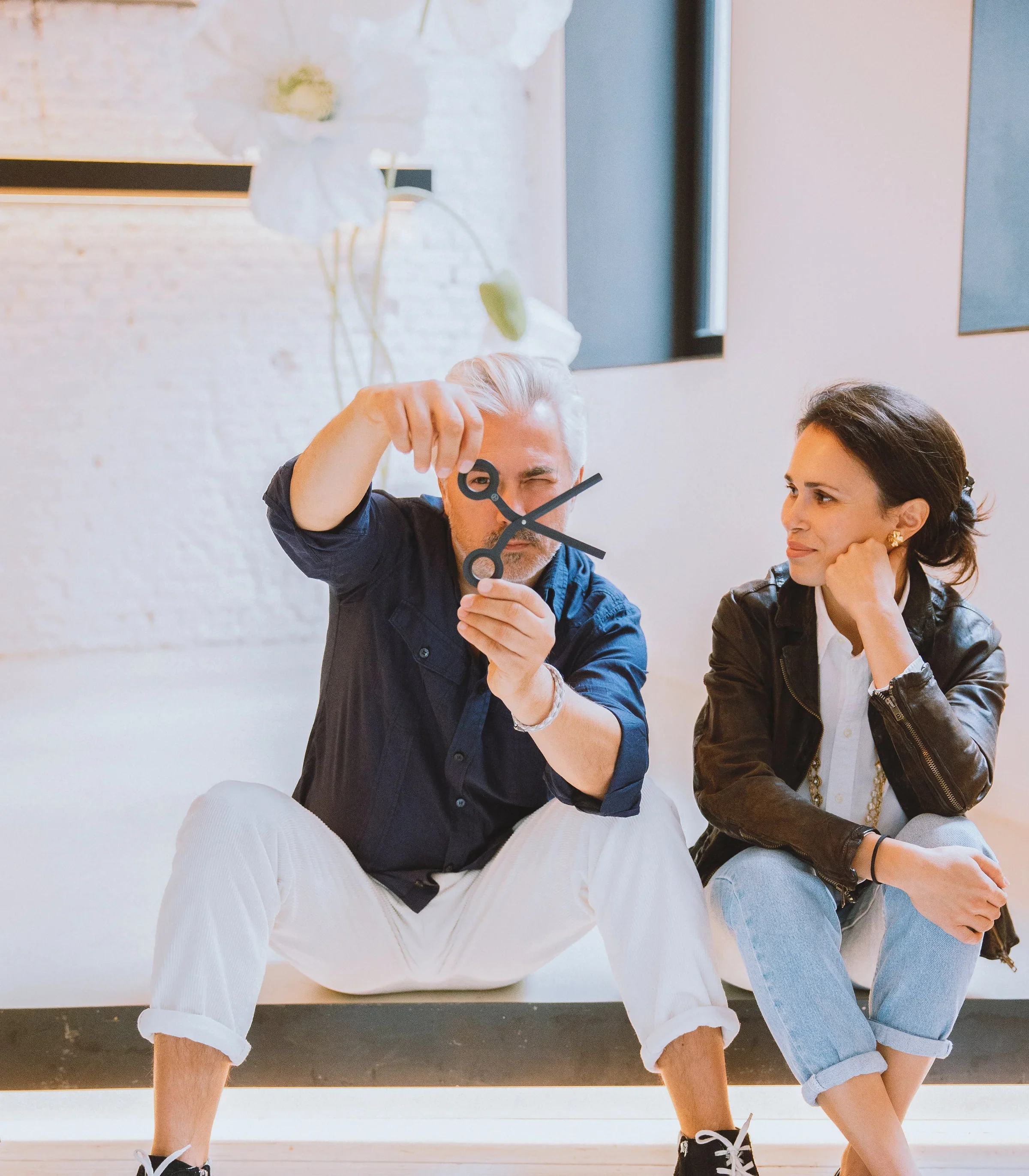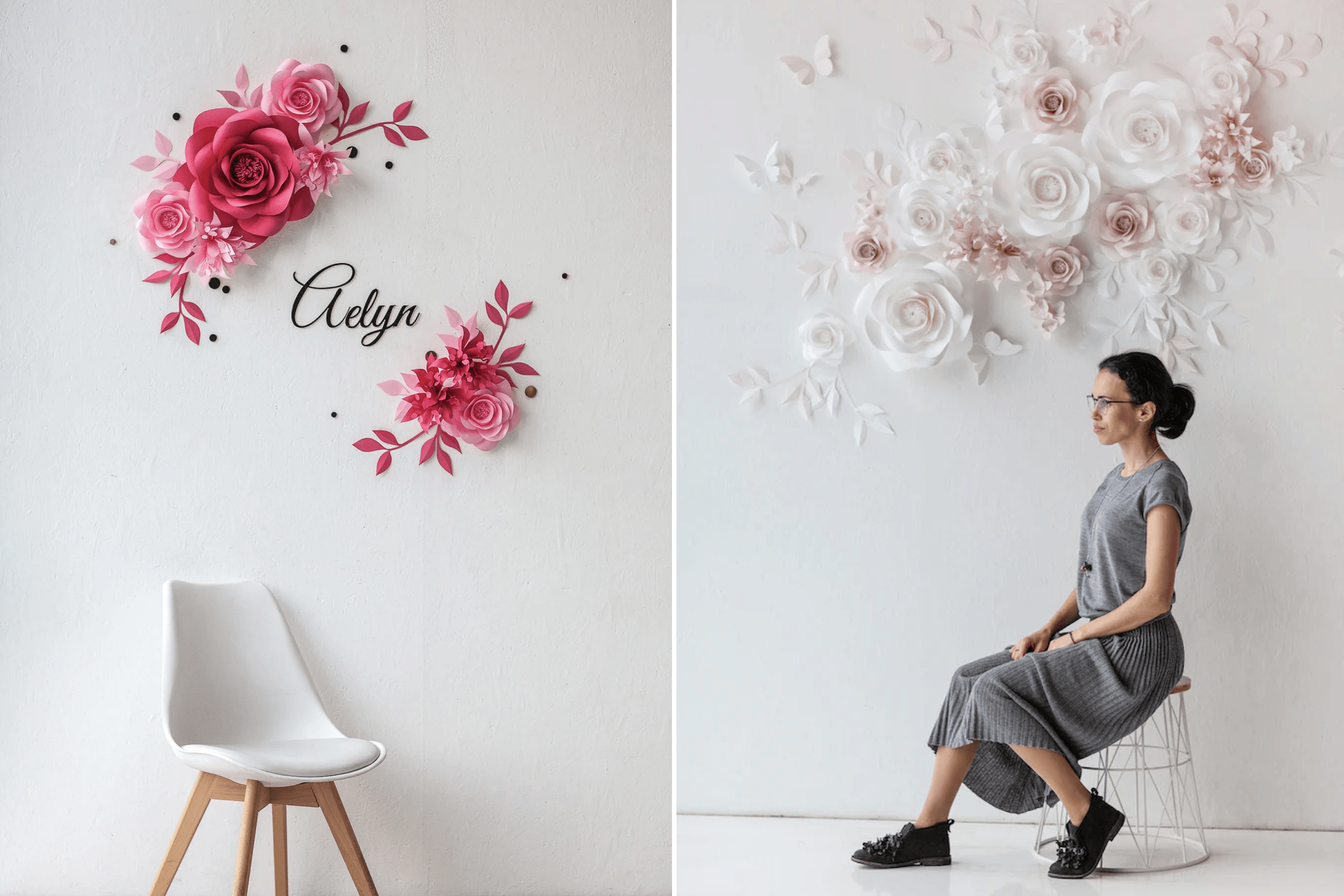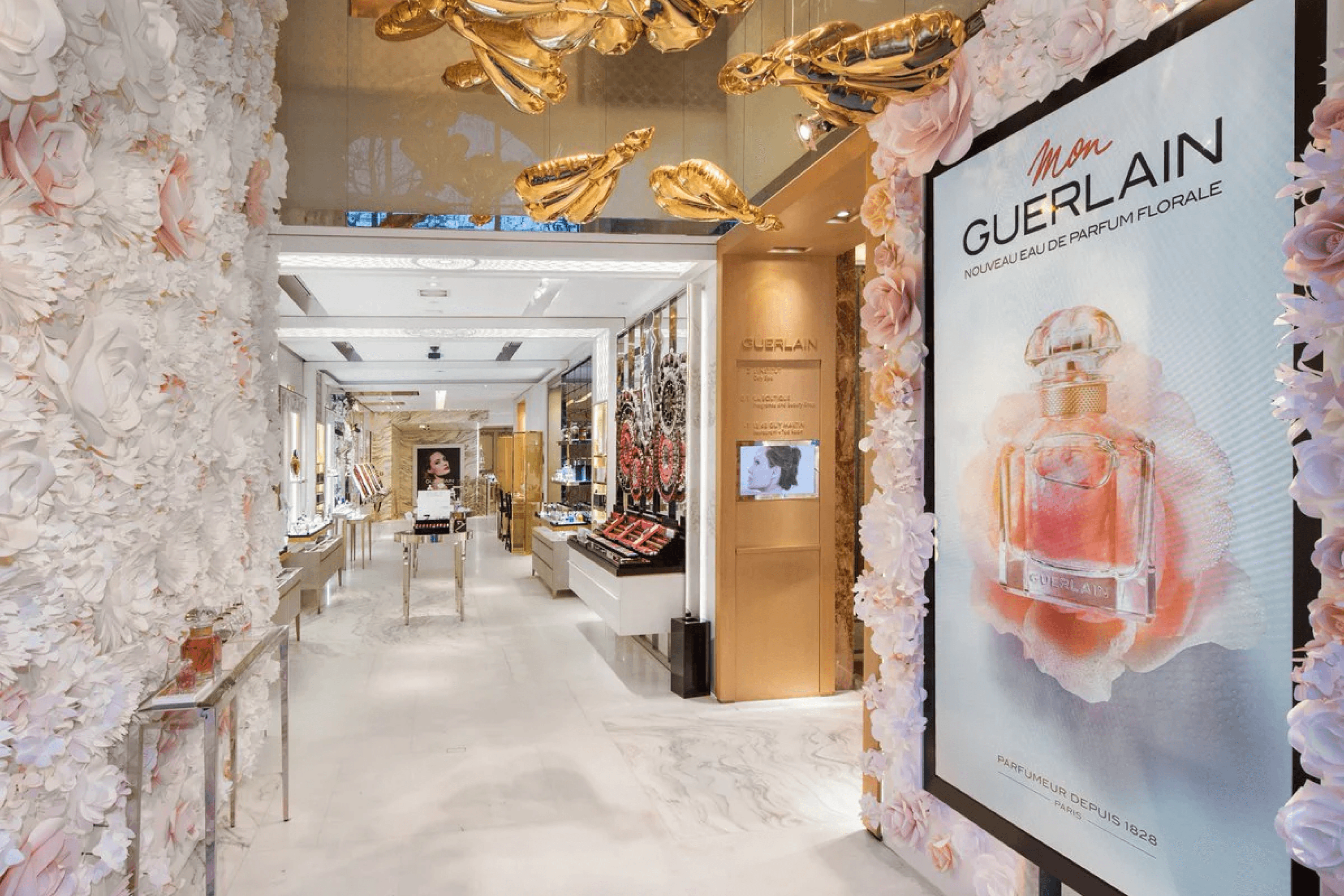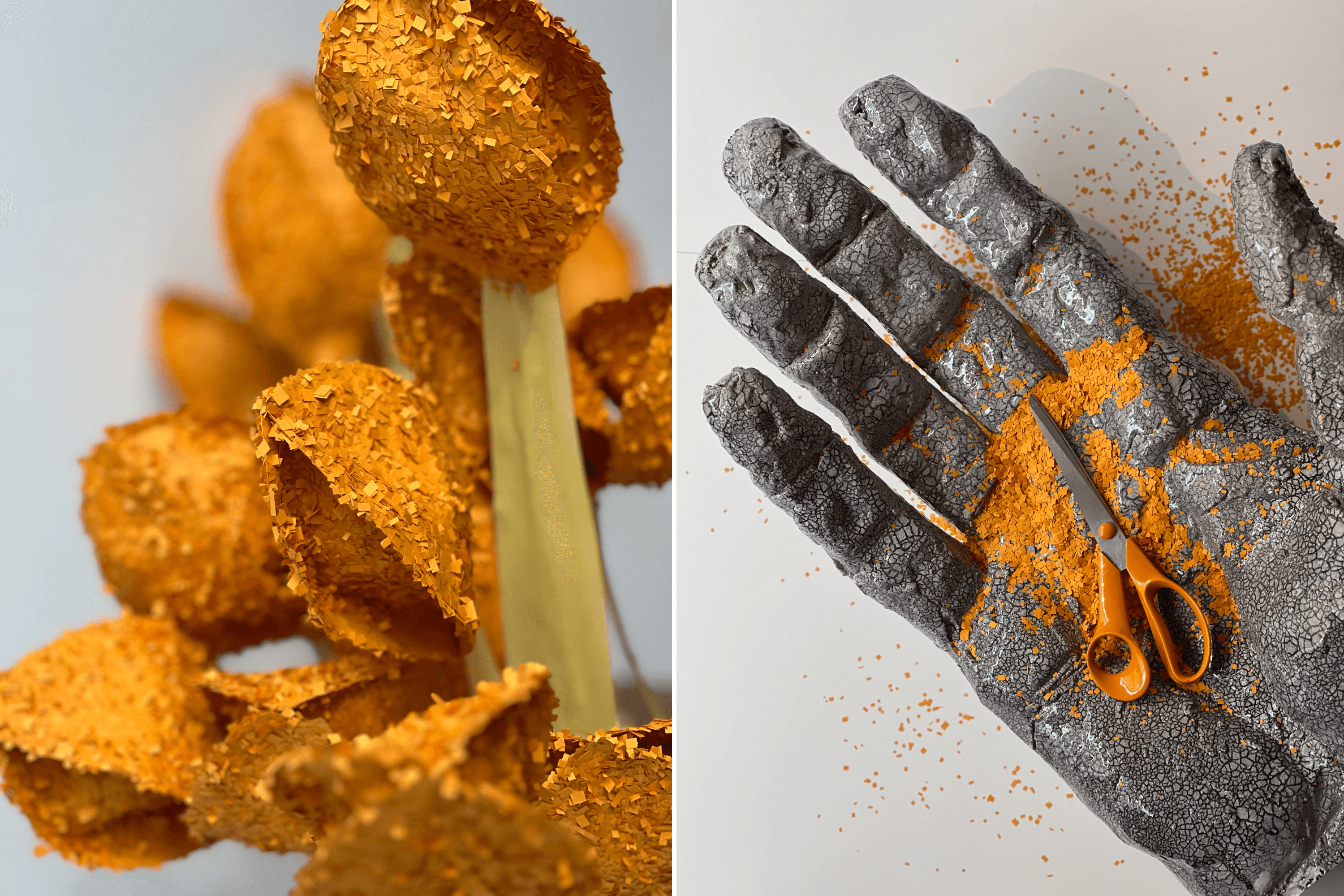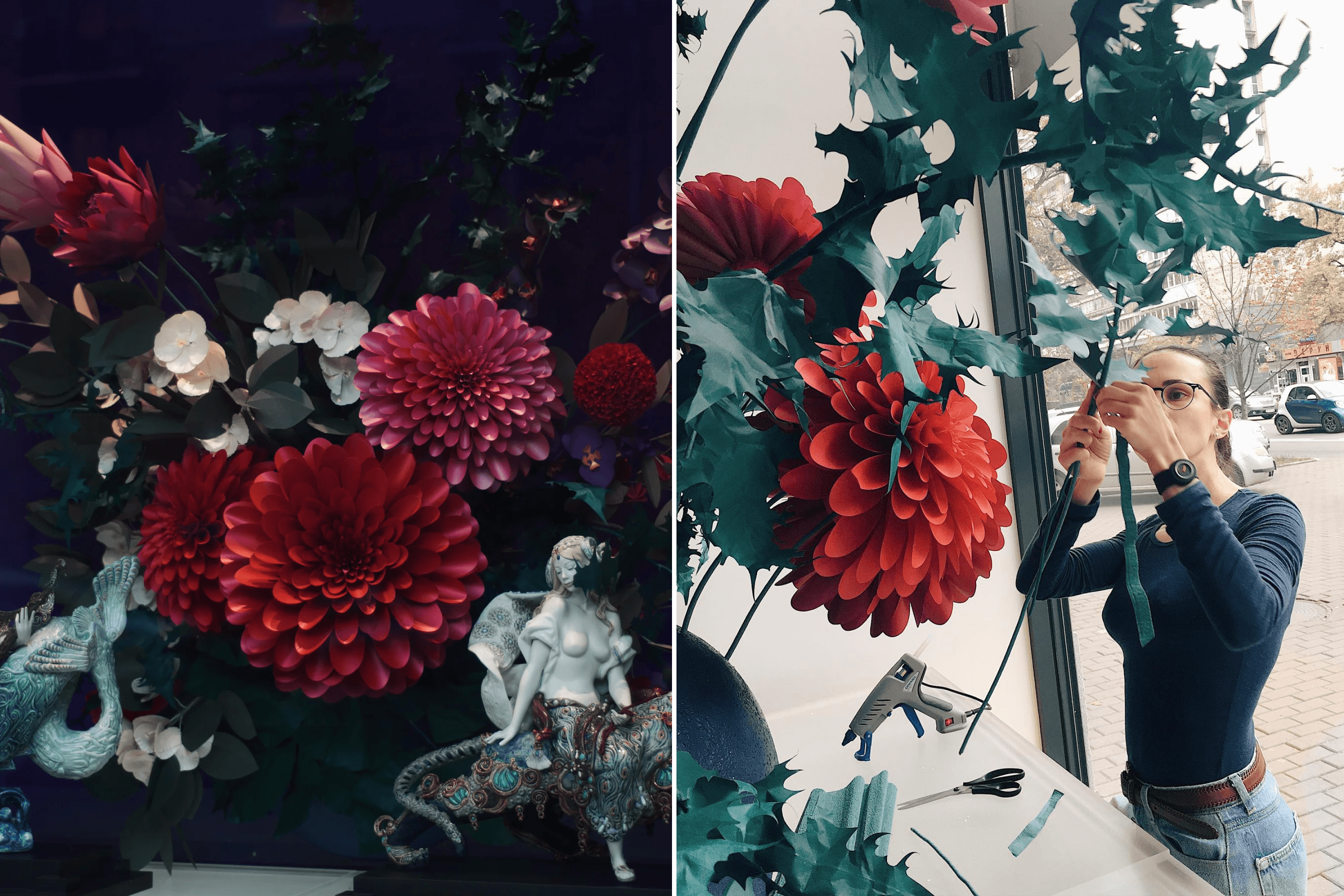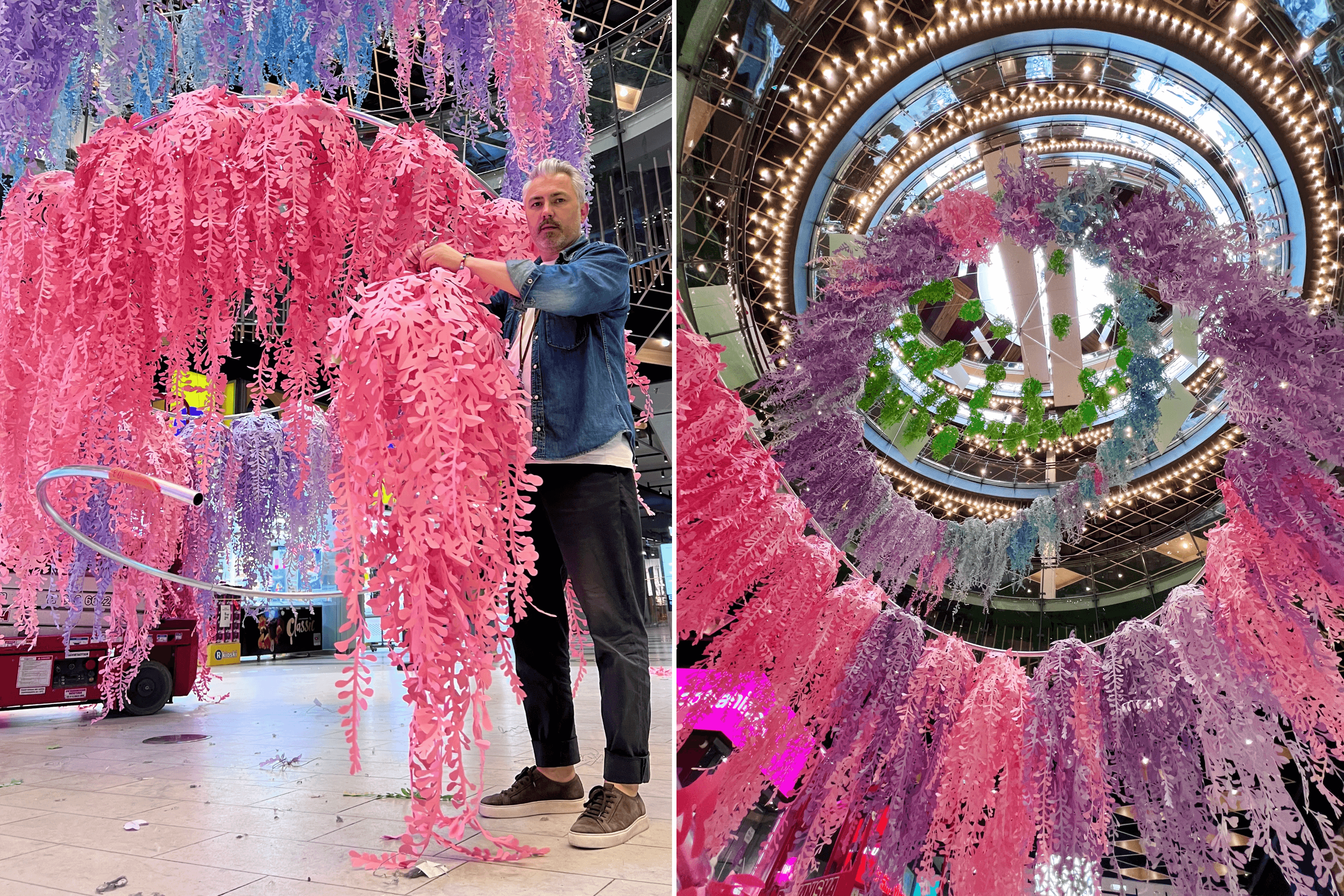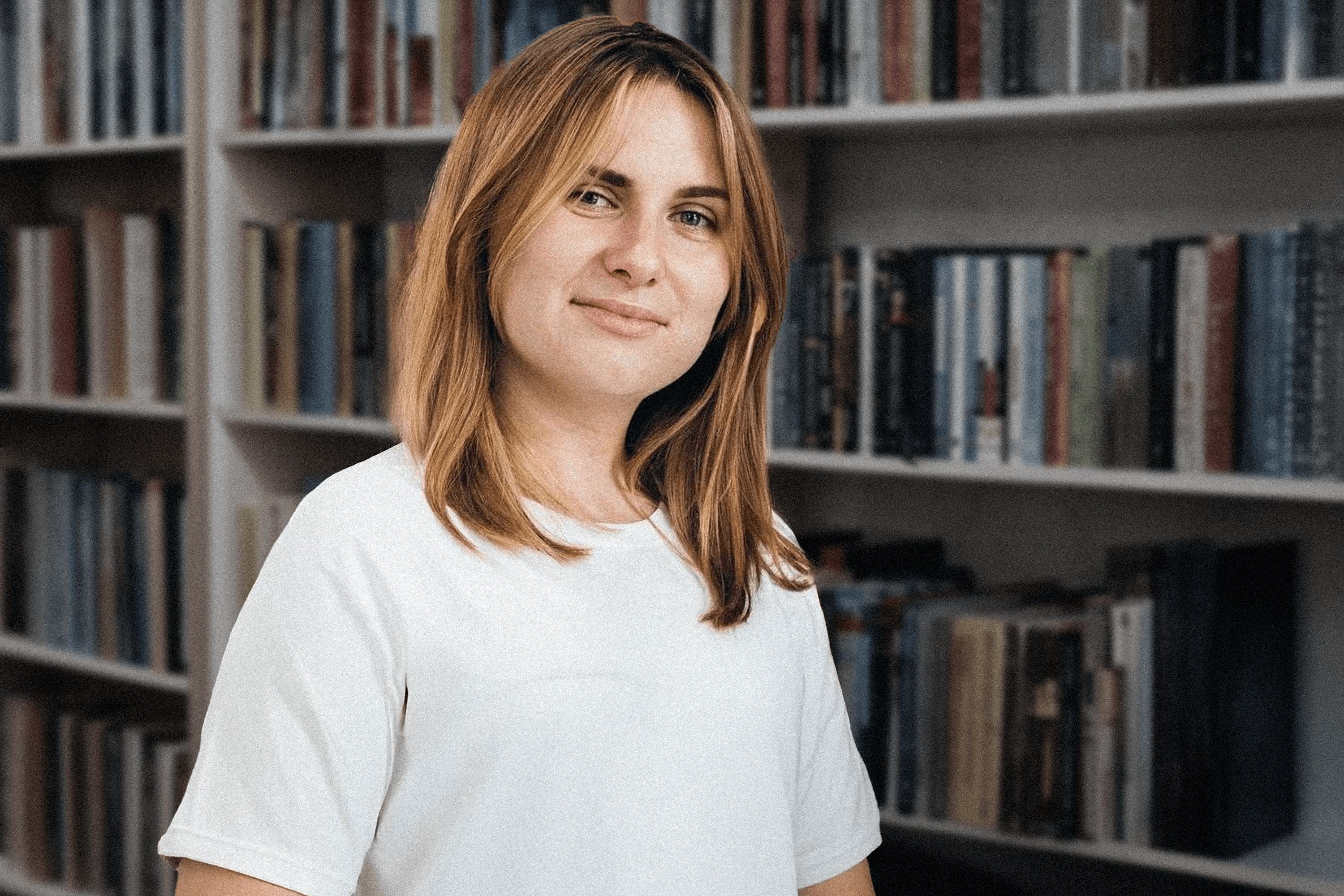Valerii and Mira Tsybukovskyi have been together for seventeen years, fourteen of which they’ve spent running a paper flower installation business. Their company, Mio Gallery, began as a small workshop in Vorzel, Ukraine, where they created custom wedding décor. Today, they live in Belgium and earn €50,000 plus a month. Back in Ukraine, the Tsybukovskyis struggled to find recognition. The local wedding market was driven by pressure and backroom deals, leaving little room for creativity or artistic freedom. But once abroad, their talent was quickly noticed. Their client list now includes global luxury names like Guerlain, LVMH Group, Sephora, Gucci, Dior, and Veuve Clicquot. Their work has graced five-star hotels, upscale restaurants, fine jewellery boutiques, and even a White House state dinner. This is their story.
1
Mira and Valerii’s story began in Kyiv in 2008. She was 21, he was 29.
Valerii grew up in Kovel, a small town in Ukraine’s Volyn region. Art had fascinated him since childhood, which led him to study wood inlay at a local vocational school after finishing high school. There, he spent much of his time drawing, sketching, and learning the basics of composition, patterns, and materials. Eventually, however, Valerii decided to pursue a more «practical» profession and earned a degree in economics in Lutsk. A few years later, he moved to Kyiv, where he began his entrepreneurial journey.
Mira was born in the Kirovohrad region, but she calls Vinnytsia home where her family moved there when she was ten. In Vinnytsia, Mira finished school and later graduated from the Pedagogical University with a degree in philology, studying English and German. After graduating, she spent a year in Austria, sharpening her German skills at the University of Vienna.
When Mira and Valerii first met, he ran a small business that supplied equipment for expo centres. Mira worked as a translator and executive assistant at an Austrian company based in Kyiv. The couple began dating and eventually got married.
The 2008 financial crisis hit many industries hard. The exhibition business, which Valerii’s company relied on, began to decline. Together with Mira, they made a decision: they still wanted to be entrepreneurs.
«Mira has a brilliant mind, sharp logic, and an incredible education, she could have succeeded in any career she chose, ” Valerii says. „But I’m grateful she decided to bring all of that together with my structured approach and gentle strength.“
Mira has always been skilled at working with her hands—sewing, embroidery, tailoring, and sculpting. While living in Vienna, she learned how to make paper pom-poms, whimsical, flower-like decorations often seen at parties. Valerii, who had connections in major companies like Danone, which hadn’t been affected by the crisis, saw an opportunity. He suggested that Mira start offering her paper creations to them.
Now and then, companies have placed small orders for pom-poms for their corporate events. That got Mira and Valerii thinking about how they could adapt their skills and connections to a new business model. Eventually, premium wedding agencies took an interest in their pom-poms. Wedding and birthday décor proved to be more profitable than the exhibition business. So, in 2011, Mio Gallery came to life.

In the early days, friends of the Tsybukovskys who had lost their jobs helped make the pom-poms. What started as a side hustle quickly grew into a mini workshop. As interest in their designs grew, event planners began requesting paper flowers along with the pom-poms. Mira and Valerii crafted them all by hand, ensuring quality and avoiding price dumping.
The key advantage of paper flowers is that they maintain their flawless appearance throughout the entire event. The Tsybukovskys were among the first in Ukraine to produce paper flowers, which helped them avoid direct competition for many years.
Mira and Valerii remember the early days as a time of experimenting a lot—testing different types of glue, experimenting with premium papers like Fedrigoni, and sourcing materials from Italy and the U.S. Later, they began working with crepe paper, which became a game-changer. Its texture and structure allowed them to create voluminous designs that held their shape beautifully. They started crafting large, detailed floral installations, something that quickly became their trademark. Business in the wedding industry took off, and income became steady. As their business grew, they started working with many clients including wealthy entrepreneurs and politicians. Most of the orders came with the general request to «make it beautiful.» At that time, one square metre of floral installation cost around $100.
In 2012, the couple welcomed their son Mark. That year also marked a turning point for their business. The high-end wedding agency Svadebnyy Perepolokh commissioned Mira and Valerii to create a floral installation inspired by Karl Lagerfeld’s Chanel runway décor—a 4×6 metre piece covered entirely in white flowers. The event took place at the InterContinental, one of Kyiv’s most exclusive and upscale hotels at the time. Their sketches were approved without hesitation, and the installation earned them $6,000.
That project helped Valerii and Mira decide to fully shift from pom-poms to paper flowers following design trends in New York and London. Flemish floral still lifes became a source of inspiration for their floral installations.
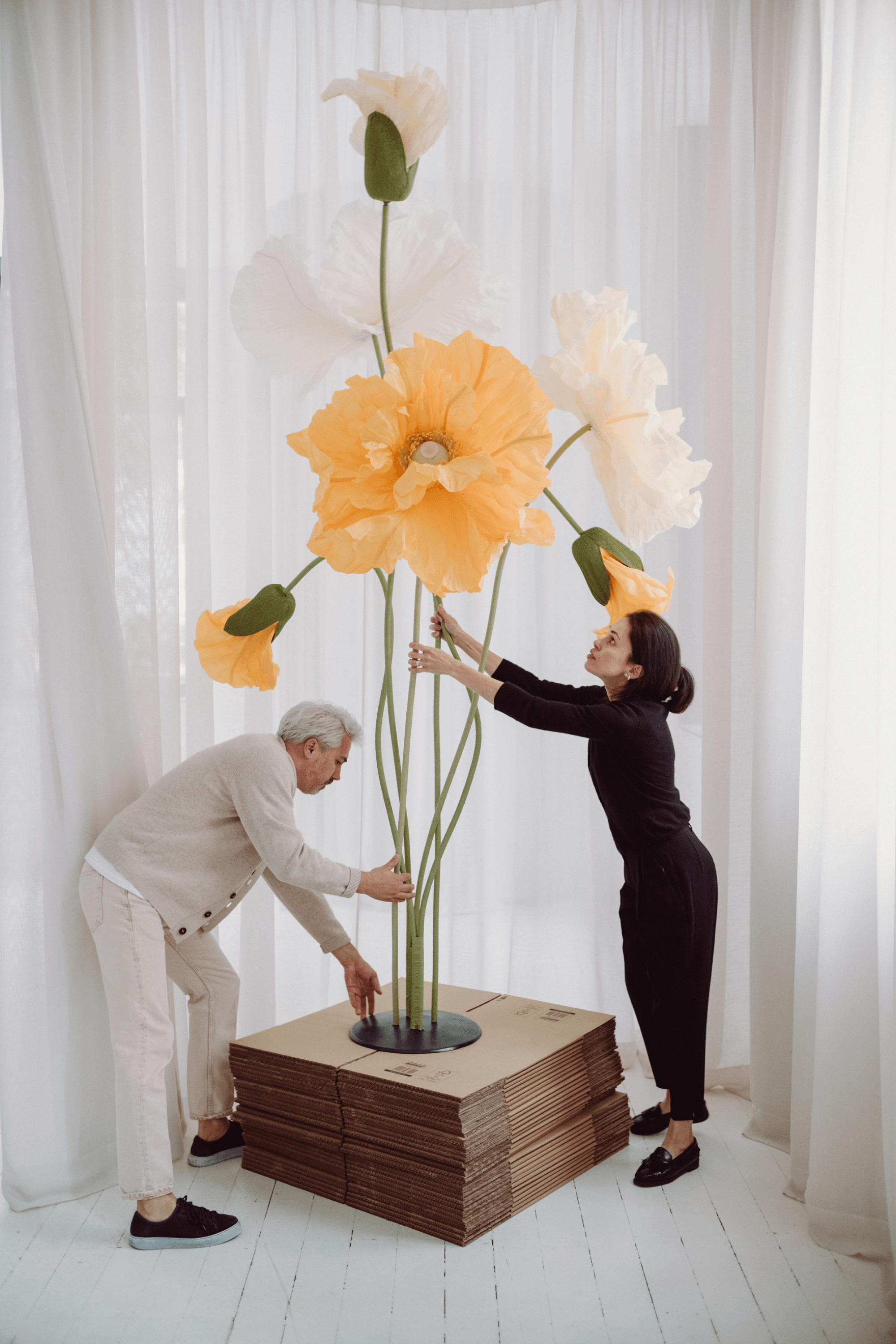
In 2013, Mira created Mio Gallery’s Instagram account and their floral creations quickly took off online. As the demand grew, the Tsybukovskys raised their prices, offering five to six signature flower designs, with projects ranging anywhere from $500 to $2,000. Orders became more frequent, but the wedding market had its complications. Many agencies operated through backdoor deals, pushing decorators for big discounts while charging clients inflated rates. Rather than play that game, Valerii and Mira decided to work directly with customers through social media. Their main priorities were maintaining quality, ensuring exclusivity, and keeping creative freedom.
Most agencies stopped reaching out to the Tsybukovskys for services, so the couple had to shift gears. That same year, they launched a shop on Etsy—an American online marketplace for handmade goods. One of their first hits was the «wishing tree», a delicate paper tree with spaces for messages on its leaves. At $80 apiece, the trees quickly gained popularity and became a consistent seller. This move opened Mio Gallery’s door to the international market. Since their pieces were difficult to replicate, which helped maintain their uniqueness. The product line expanded, and their bestsellers became large paper floral wall installations. Parents often bought them to decorate the walls above cribs. These wall bouquets could be customized like building blocks—by size, colour, type, and number of flowers. It became a trend and remains one of the company’s top-selling products.
2
In 2014, Valerii and Mira bought an apartment in Vorzel, a quiet town just outside Kyiv. City life didn’t appeal to them. The air in the capital wasn’t great for their young son, and with the Euromaidan protests escalating in late 2013, the city no longer felt like a safe place to raise a family. Surrounded by forest and pine trees, Vorzel was the perfect place to grow their business. They set up a small home studio with three assistants who helped with prep work. Their personal and professional lives were tightly woven together: Valerii would prep materials while Mira cared for their son then they’d swap. It wasn’t until 2015 that they finally managed to rent a proper studio space and draw a line between work and family life.
«We were together all the time and somehow never ran out of things to talk about, ” Valerii recalls. „Watching the kids grow, building the business, it brought us real joy.“
Mira adds that from the very beginning, they shared a similar mindset, which helped them stay on the same page. There were no fixed roles, they simply took turns with whatever needed to be done. As their income steadily grew, so did their motivation. Arguments were rare, and most of the time they were about pricing. Mira was cautious about setting higher rates, while Valerii pushed for their prices to reflect the growing value of their skills and experience.

«You know how the New York Stock Exchange has those bull and bear statues?» he says. «When markets go up, it’s called a bull trend—the bull drives its horns upward. It’s a bear trend when they fall because bears strike down. I’ve always felt like the bull, pushing the business forward. Working solo never appealed to me. It’s just not efficient, especially when your typical Ukrainian client wants everything fast, cheap, and done yesterday.»
«In the beginning, my husband was quite critical of our work, it took time for him to turn that into something constructive, ” says Mira. „We agreed early on: there’s enough clutter in the world, and we don’t want to contribute to it. Our goal is to create art, something truly meaningful.“
In 2016, Mira and Valerii launched their website with a built-in payment system. By then, they were positioning themselves as artist-decorators focusing on paper flowers. That December, they got a major order from the brand Guerlain, a €20,000 decor project for the brand’s boutique in Paris. Mira and Valerii handled the entire process themselves, from concept to installation.
At times, the Tsybukovskys had no idea who the end client was. On one occasion, an event agency commissioned floral decor for a formal dinner. Six months later, the client revealed that the decor had been used at a White House dinner to decorate the tables. Due to a non-disclosure agreement, they weren’t even allowed to have photos.
2016 brought another important project: Jacu Straus, the creative director of the Lore Group hotel chain, reached out with a proposal to redesign the lobby of a hotel in Washington. The references were familiar Flemish still-life paintings. Creating a 4-metre-tall installation where each flower would be a different type and mounting the entire piece into a glass cabinet near the ceiling was a true challenge!
In 2017, the family welcomed their second son, Lev. Mira and Valeriy continued working on international projects. However, they never received much recognition in Ukraine. Mira still finds it disheartening that their work was acknowledged and celebrated in Europe and North America, but not at home. Despite that, the business kept growing and their rates reflected that growth. A set of 16 small flowers sold for $180, and a square metre of custom floral installation started at $450.
3
In 2018, Mira and Valeriy were invited to Antwerp to design the interior for MOOY. BEAUTY CONCEPT STORE. The city left a deep impression on Mira, she immediately fell in love with it. The calm, the safety, and the welcoming atmosphere made her feel at home. Inspired by that feeling, she proposed the idea of relocating. Valeriy took some time to consider the idea.
Not long after, another opportunity arrived from Antwerp. This time—to design the decor for the Botanic Sanctuary Antwerp, a five-star hotel and the city’s first member of the prestigious Leading Hotels of the World network. The couple installed massive four-metre-tall floral sculptures, calling it one of the most technically demanding projects of their career. Within a year, Valeriy and Mira decided to relocate to Antwerp. By that time, almost all of their clients were already in Europe and the U.S., and they also wanted to give their kids access to a European education.
Moving wasn’t easy. It took the Tsybukovskys half a year to compile the paperwork needed for a so-called «talent visa, ” a permit granted to professionals in the arts and cultural sectors. After compiling a 400-page application and passing an interview with the ambassador, their case was unexpectedly halted. The reason turned out to be painfully unfair: Mira didn’t speak Dutch and had mistaken a dozen official embassy emails for spam and missed them entirely.
In October 2020, during a short lockdown break, Mira and Valeriy finally got their visas. hey quickly found a place to live, and at the end of December, they headed to Antwerp with their children and two suitcases. The rest of their things didn’t arrive until a month later. Mira remembers spending Christmas in a nearly empty apartment but feeling incredibly happy.
The couple immediately applied for their ID cards in Belgium and registered a company. Back in Ukraine, they had operated as sole proprietors with low taxes, but Belgium’s system was different: the income tax rate for entrepreneurs was 25%. Even so, they adapted quickly.
Over the next two years, the Tsybukovskys worked hard and built a strong recognition across Europe. Antwerp immediately felt like home. They say they never experienced the typical challenges of emigration or isolation. In fact, locals showed a genuine interest in their work.

4
These days, Mira and Valeriy live in the heart of Antwerp, near the Royal Museum of Fine Arts. They often travel for work, raise their two sons, and continue growing their business. In March 2022, during the occupation of the Kyiv region, a shell destroyed their home studio in Vorzel along with all their supplies, materials, and personal belongings. One of their longtime clients, Joan Cardy, owner of Cardy Group and a key contractor for the Riggs hotel, sent them $5,000 to help them get back on their feet.
The Tsibukovskys' business now earns a monthly income starting from €50,000. Mira and Valeriy work with high-quality materials sourced from Italy, France, Germany, and the United Kingdom. Their client list includes Guerlain, LVMH Group, Gucci, Sephora, Lore Group, Riggs Hotel, Veuve Clicquot, Rituals, Botanic Sanctuary, ELLE, and Marie Claire.
The Tsibukovskys firmly decline any request to replicate AI-generated images, as they believe such work to be unfeasible. Their projects range from €1,000 to €30,000, depending on the complexity and scale. Despite their success, the couple still works alone and does not plan to expand their team, preferring to maintain full control over the business and ensure the highest quality.
Like many creative entrepreneurs, the Tsibukovskys typically work with two kinds of clients: those with a clear, specific vision, and those who fully trust their creativity. To deliver their best work, they rely on well-defined technical specifications: volume, dimensions, shape, and colour. They also have clear criteria for turning down orders. If a project doesn’t align with their style, if a client becomes overly demanding, or if there are major changes to the brief mid-process, they’ll either raise the price or suggest the client look for alternatives on the market.
Valerii and Mira are currently working on two major projects, one of them is a custom installation for CHANEL with negotiations currently underway. New orders come in daily and ensure a steady income for months ahead. The Tsibukovskys are confident that the handmade market, especially paper art, has great potential and deserves far more recognition.
Mira says that the COVID-19 pandemic significantly contributed to the growth of the global handmade market. «Lots of people lost their jobs, while others shifted to working from home which gave them more time to create. During the lockdowns, online shopping became more popular. Consumers, especially families, started valuing unique, personalized items more. They chose exclusive, handmade products. With import restrictions making logistics more difficult, shoppers turned to local makers. For many, creativity became a way to deal with stress. Handmade goods weren’t just a side hustle anymore, they became a form of self-expression.»

